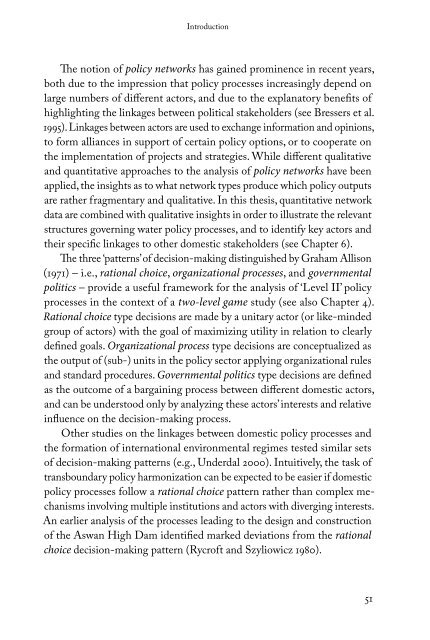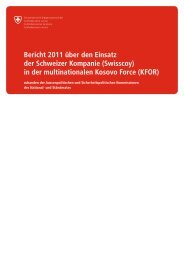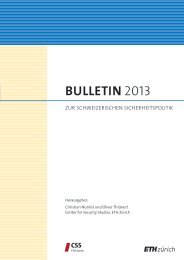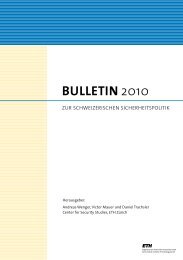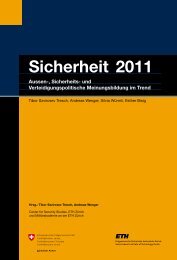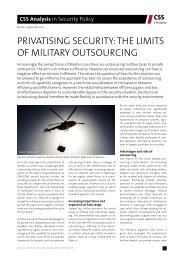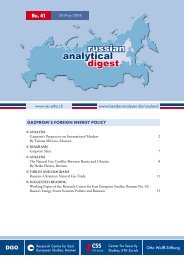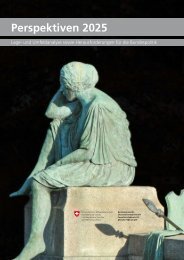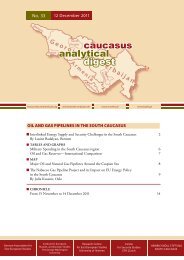Double-Edged Hydropolitics on the Nile - Center for Security Studies ...
Double-Edged Hydropolitics on the Nile - Center for Security Studies ...
Double-Edged Hydropolitics on the Nile - Center for Security Studies ...
You also want an ePaper? Increase the reach of your titles
YUMPU automatically turns print PDFs into web optimized ePapers that Google loves.
Introducti<strong>on</strong><br />
The noti<strong>on</strong> of policy networks has gained prominence in recent years,<br />
both due to <strong>the</strong> impressi<strong>on</strong> that policy processes increasingly depend <strong>on</strong><br />
large numbers of different actors, and due to <strong>the</strong> explanatory benefits of<br />
highlighting <strong>the</strong> linkages between political stakeholders (see Bressers et al.<br />
1995). Linkages between actors are used to exchange in<strong>for</strong>mati<strong>on</strong> and opini<strong>on</strong>s,<br />
to <strong>for</strong>m alliances in support of certain policy opti<strong>on</strong>s, or to cooperate <strong>on</strong><br />
<strong>the</strong> implementati<strong>on</strong> of projects and strategies. While different qualitative<br />
and quantitative approaches to <strong>the</strong> analysis of policy networks have been<br />
applied, <strong>the</strong> insights as to what network types produce which policy outputs<br />
are ra<strong>the</strong>r fragmentary and qualitative. In this <strong>the</strong>sis, quantitative network<br />
data are combined with qualitative insights in order to illustrate <strong>the</strong> relevant<br />
structures governing water policy processes, and to identify key actors and<br />
<strong>the</strong>ir specific linkages to o<strong>the</strong>r domestic stakeholders (see Chapter 6).<br />
The three ‘patterns’ of decisi<strong>on</strong>-making distinguished by Graham Allis<strong>on</strong><br />
(1971) – i.e., rati<strong>on</strong>al choice, organizati<strong>on</strong>al processes, and governmental<br />
politics – provide a useful framework <strong>for</strong> <strong>the</strong> analysis of ‘Level II’ policy<br />
processes in <strong>the</strong> c<strong>on</strong>text of a two-level game study (see also Chapter 4).<br />
Rati<strong>on</strong>al choice type decisi<strong>on</strong>s are made by a unitary actor (or like-minded<br />
group of actors) with <strong>the</strong> goal of maximizing utility in relati<strong>on</strong> to clearly<br />
defined goals. Organizati<strong>on</strong>al process type decisi<strong>on</strong>s are c<strong>on</strong>ceptualized as<br />
<strong>the</strong> output of (sub-) units in <strong>the</strong> policy sector applying organizati<strong>on</strong>al rules<br />
and standard procedures. Governmental politics type decisi<strong>on</strong>s are defined<br />
as <strong>the</strong> outcome of a bargaining process between different domestic actors,<br />
and can be understood <strong>on</strong>ly by analyzing <strong>the</strong>se actors’ interests and relative<br />
influence <strong>on</strong> <strong>the</strong> decisi<strong>on</strong>-making process.<br />
O<strong>the</strong>r studies <strong>on</strong> <strong>the</strong> linkages between domestic policy processes and<br />
<strong>the</strong> <strong>for</strong>mati<strong>on</strong> of internati<strong>on</strong>al envir<strong>on</strong>mental regimes tested similar sets<br />
of decisi<strong>on</strong>-making patterns (e.g., Underdal 2000). Intuitively, <strong>the</strong> task of<br />
transboundary policy harm<strong>on</strong>izati<strong>on</strong> can be expected to be easier if domestic<br />
policy processes follow a rati<strong>on</strong>al choice pattern ra<strong>the</strong>r than complex mechanisms<br />
involving multiple instituti<strong>on</strong>s and actors with diverging interests.<br />
An earlier analysis of <strong>the</strong> processes leading to <strong>the</strong> design and c<strong>on</strong>structi<strong>on</strong><br />
of <strong>the</strong> Aswan High Dam identified marked deviati<strong>on</strong>s from <strong>the</strong> rati<strong>on</strong>al<br />
choice decisi<strong>on</strong>-making pattern (Rycroft and Szyliowicz 1980).<br />
51


